The Wet Tropics region is home to about a third of Australia’s 315 mammal species – including unique green possums, marsupial
The Wet Tropics is home to 13 mammal species which are found nowhere else in the world and two are endangered Tropical Bettong and Mahogany Glider – are rainforest dwellers.
Platypus
The Platypus is an egg laying mammal, has a soft and rubbery, broad bill and a flat streamline body covered in dense, dark brown fur. The tail is broad and flat, and the legs are short and stout with webbed feet. The male platypus has a large spur on each hind ankle, connected by ducts to a poison gland. (a wound from a spur can be extremely painful). The average male is 50cm long and weighs 2kg. The Platypus is an egg laying mammal, has a soft and rubbery, broad bill and a flat streamline body covered in dense, dark brown fur. The tail is broad and flat, and the legs are short and stout with webbed feet. The male platypus has a large spur on each hind ankle, connected by ducts to a poison gland. The average male is 50cm long and weighs 2kg.
They are semi-aquatic, spending half the day in the water feeding, and the rest on land and in a burrow. Females build nesting burrows lined with leaves and vegetation that is carried in her curled up tail. Platypus are carnivorous, feeding on insect larvae, freshwater shrimps and crayfish.
If you want to see Platypus in the wild, choose a place they are known to frequent, (such as Peterson Creek near Yungaburra). Sit quietly, and watch for the tell-tale large slow concentric ripples which indicate a Platypus is present. Platypus are usually seen near dawn or dusk.
Information – courtesy of Qld Department of Environment and Heritage – https://www.platypus.asn.au/
Lumholtz Tree-Kangaroo
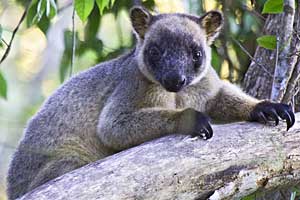 The Lumholtz Tree-kangaroo is listed ‘near threatened’ under the Qld Nature Conservation act and lives in rainforests and adjacent wet tropic forests in Far North Qld. Good places in Yungaburra are Curtain Fig Tree, Peterson Creek area near Yungaburra, Mt Hypipamee National Park, Malanda Falls and Wongabel State Forest. Try looking first thing in the morning or late afternoon, or by torch at night.
The Lumholtz Tree-kangaroo is listed ‘near threatened’ under the Qld Nature Conservation act and lives in rainforests and adjacent wet tropic forests in Far North Qld. Good places in Yungaburra are Curtain Fig Tree, Peterson Creek area near Yungaburra, Mt Hypipamee National Park, Malanda Falls and Wongabel State Forest. Try looking first thing in the morning or late afternoon, or by torch at night.
They are adapted to life in the trees with an exceptionally long tail used for balance. Compared to other kangaroos they have stronger forelimbs, shorter and broader hind feet and longer curved claws on all feet for climbing and gripping. They eat leaves and occasionally fruits or flowers, are periodic in their activity, but most active at night. Information supplied by The Tree-kangaroo and Mammal Group – https://www.tree-kangaroo.net/
Musky Rat-Kangaroo
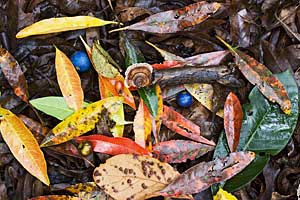 The Musky Rat-Kangaroo is regularly seen around the volcanic lake Eacham and Lake Barrine and around the bases of the famous Curtain Fig and Cathedral Fig trees on the near Yungaburra. Look for them in the morning and afternoon foraging for fruit on the forest floor. Bearing two young at a time and possessing a thumb on their hind feet, they are thought to be the most primitive extant member of the kangaroo family.
The Musky Rat-Kangaroo is regularly seen around the volcanic lake Eacham and Lake Barrine and around the bases of the famous Curtain Fig and Cathedral Fig trees on the near Yungaburra. Look for them in the morning and afternoon foraging for fruit on the forest floor. Bearing two young at a time and possessing a thumb on their hind feet, they are thought to be the most primitive extant member of the kangaroo family.
The fur is a velvety rusty brown colour. The naked tail is prehensile and used for carrying leaves as nesting material. The name refers to the musky scent emitted by both sexes. Their diet consists of insects and worms, berries, fruits and tuberous roots.
Possums & Gliders
The Wet Tropics region has the highest possum diversity in Australia!
In the rainforests around Yungaburra, you will might see the following possums. If spotlighting use only moderate strength (30w) lights to find the animals and then avoid strong white lights being directed into the animal’s eyes. A red filter will make the animals more relaxed and provide you with a better experience too.
Green Ringtail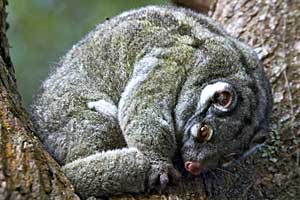 The Green Ringtail is so named because of the colour illusion created by its thick fur. During the day these possums sleep in the sub-storey on horizontal branches. The longer guard hairs are somewhat reflective of the green sheen of the leaves. The combination of white, grey, charcoal and caramel hairs adds to the illusion of green. This possum eats many poisonous plants, some green fruit and during the day ingests its own droppings. With this diet it is no wonder that they are usually slow moving. Adults are solitary.
The Green Ringtail is so named because of the colour illusion created by its thick fur. During the day these possums sleep in the sub-storey on horizontal branches. The longer guard hairs are somewhat reflective of the green sheen of the leaves. The combination of white, grey, charcoal and caramel hairs adds to the illusion of green. This possum eats many poisonous plants, some green fruit and during the day ingests its own droppings. With this diet it is no wonder that they are usually slow moving. Adults are solitary.
Lemuroid Ringtail Possum is restricted to upland rainforests. Endemic to Tropical North Queensland. Mostly chocolate to charcoal-brown in colour. Tail is densely furred along the entire length. This is the most agile of the rainforest possums with leaps of two metres onto the leaves of another branch not uncommon. They have a bright yellow eye-shine.
Herbert River Ringtail Possum
The emblem of the Queensland Parks and Wildlife Service is an attractive black and white ringtail possum from upland and highland altitudes. Affectionately as ‘Herbie’, it prefers leaves with a high protein content. They eat more flowers and fruit than other ringtails. Their den is usually in a tree hollow or in large ferns. Two young are produced and after nearly four months, they are ready to leave the pouch. The brown juveniles spend only two weeks being carried on their mother’s back. They hang around with their parents for some time. One young is ‘parked’ in low foliage while the other is taken off feeding.
Common Brushtail Possum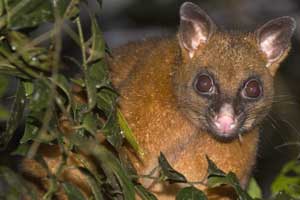 Common Brushtail possums are found in many habitats. During the day, Brushtail possums stay in tree hollows or fallen logs. At night they come out to feed on flowers, fruit, buds and leaves of native plants. The Brushtail is a large possum with bushy tail and pointy ears. The colour varies, but in the rainforests of the Tablelands they are a brown coppery colour with a hairy black tail . In the drier areas locally they are silver-grey with white or cream bellies. They breed throughout the year, and snarling and growling are common as they fight over mating or territory.
Common Brushtail possums are found in many habitats. During the day, Brushtail possums stay in tree hollows or fallen logs. At night they come out to feed on flowers, fruit, buds and leaves of native plants. The Brushtail is a large possum with bushy tail and pointy ears. The colour varies, but in the rainforests of the Tablelands they are a brown coppery colour with a hairy black tail . In the drier areas locally they are silver-grey with white or cream bellies. They breed throughout the year, and snarling and growling are common as they fight over mating or territory.
Striped Possum
A very attractive but active possum. The stripes are usually a striking black and white but grey may be present also and even replace the black or white. This possum has a sweet tooth but primarily eats beetle larva which it extracts form rotting timber. Its long fourth finger is used to drag grubs out of their tunnels. This possum is the ‘brainiest’ of the marsupials. While a highly active possum, it will often freeze with its face hidden if found in a spotlight.
Sugar Glider
These cute little animals have big ears and eyes, grey fur, a long bushy tail and a dark stripe along the back. They use membranes on either side of its body to glide up to 50m through the air between their favourite trees. Living in family groups of up to seven adults with their young, this is a very sociable animal.
Yellow Bellied Glider
Is found in the tall eucalypt forest west of the rainforests. As well as eating insects it opens the bark of Red Stringybark trees to access the sap. Other gliders may use the cuts too.
Rodents
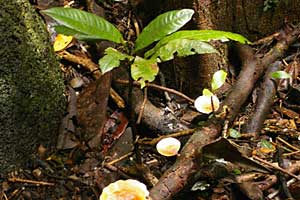 Australia has its native rodents and recently introduced pests.
Australia has its native rodents and recently introduced pests.
Giant White-tailed Rat This is a huge rat with the last half of its tail white. It is largely arboreal, is omnivorous and will grind its teeth if disturbed.
Many thanks to Alan’s Wildlife Tours for the mammal information. Expand your wildlife viewing opportunities by taking a guided tour or cruise on one of the lakes. View Atherton Tablelands Tours page for details.
See you in Yungaburra!